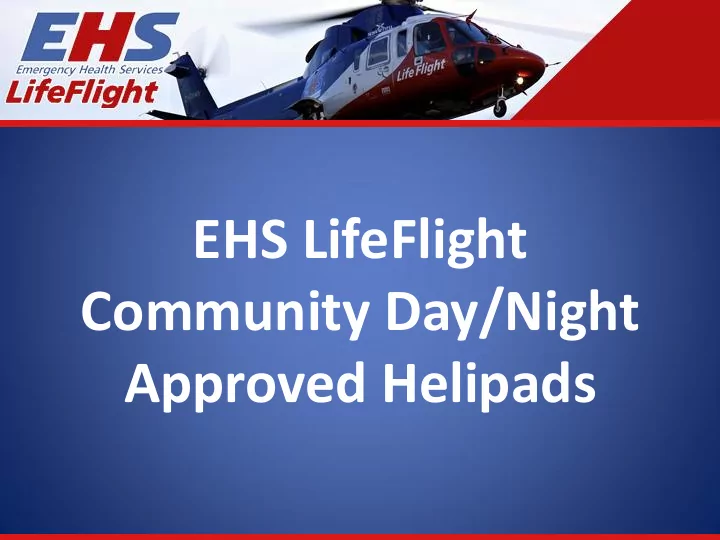

EHS LifeFlight Community Day/Night Approved Helipads
Steps to guide selection of a permanent Community Day / Night Helipad • Look for a large firm and level field / open area, free of any hazards in or above the helipad and away from traffic / children. • The helipad itself must be 110’ x 110’ firm and level. • There must be at least one clear angled approach into the helipad (so that the helicopter will not hit anything coming into land).
• Take into consideration the prevailing wind; normally out of the West for Nova Scotia. The helicopter will approach into wind therefore the approach clearing should be on the east side of the helipad. This should be a wide angled clearing…not just a narrow path leading to the helipad. • There must also be a clear area on the opposite of the helipad (about half the size of the helipad), free of any hazards; called the overshoot area. • Obtain permission from the land owner to set up a permanent helipad on the site.
• If you have one approach path you’ll need to purchase 11 two ft high orange florescent highway cones with retro reflective tape around the cones and 11 two foot concrete patio stones. • Drill a hole through each corner of the cone and through the concrete patio stone. • 4 bolts anchor the cone to the patio stone • Do this for all 11 cones / patio stones • If you have an area large enough with two clear approach paths (either 90 or 180 degrees apart from one another), you’ll need to purchase 14 cones and patio stones.
• Place one cone/patio stone on each corner of the helipad 110’ft apart. • Place one cone/patio stone in the middle of each side of the helipad • These eight cones/patio stones will mark the helipad perimeter. • Look closely to ensure there are no hazards inside or above the square area you have just laid out. • Lay out three cones approximately 30 feet apart from each other in a line; identifying the safe approach path. Do this for each approach path.
Prevailing Winds Overshoot Landing Zone Area 110 ft x 110 ft
• Contact EHS LifeFlight to purchase a helipad lighting kit and arrange for a Helipad inspection. The lighting kit will be brought to you at the time of inspection. • If the helipad is deemed safe for EHS LifeFlight operations, we will drill the cones to secure the lights to. • The lighting kit must be stored in a warm dry location when not in use. The cones however must remain on site and undisturbed year round. • You will be briefed on specific operating procedures once final approval is granted. • Note EHS LifeFlight will not land at the helipad after dark unless the helipad has passed a yearly safety inspection.
Helipad Maintenance • Keep the helipad and approach paths mowed in the summer and clear of deep snow in the winter. If the cones are not visible, EHS LifeFlight will not land • Keep the helipad clear of foreign object debris • Inspect the cones on a regular basis for wear / replace as necessary • Notify EHS LifeFlight ASAP if the helipad ceases to operate or becomes temporarily un-useable
Recommend
More recommend